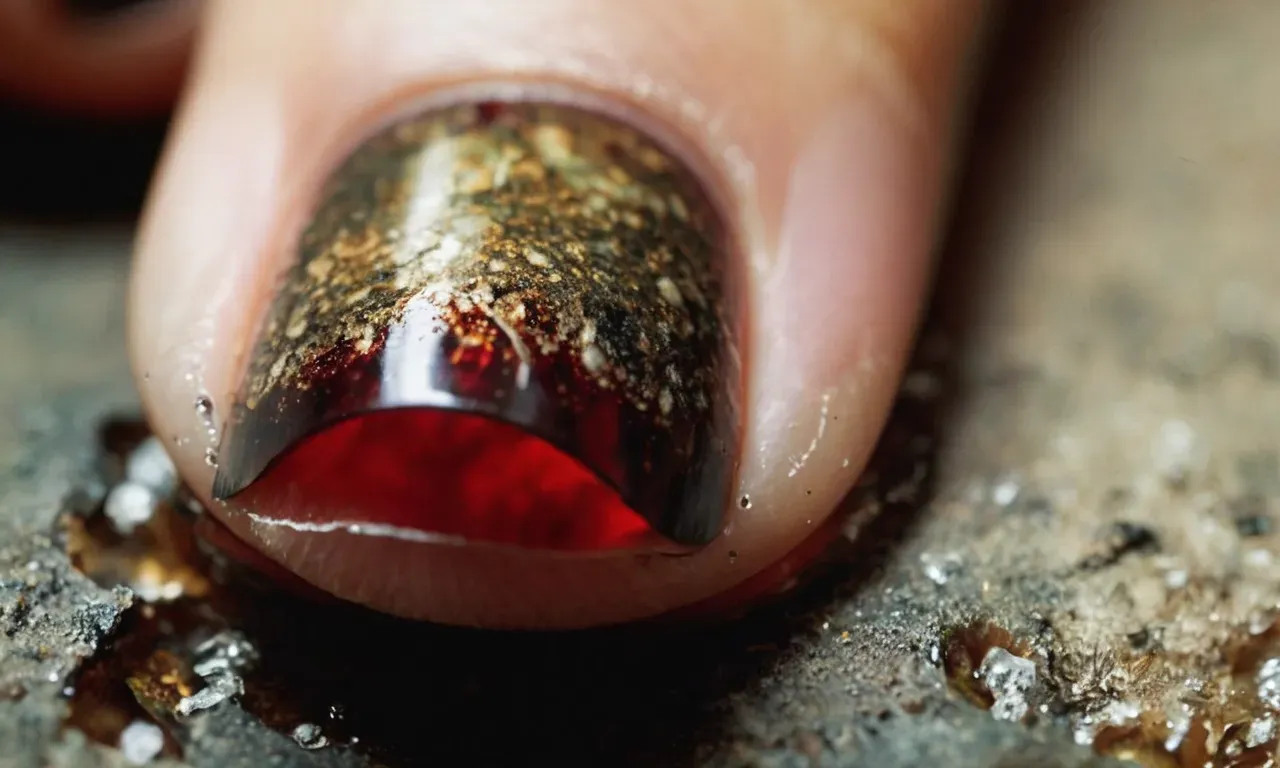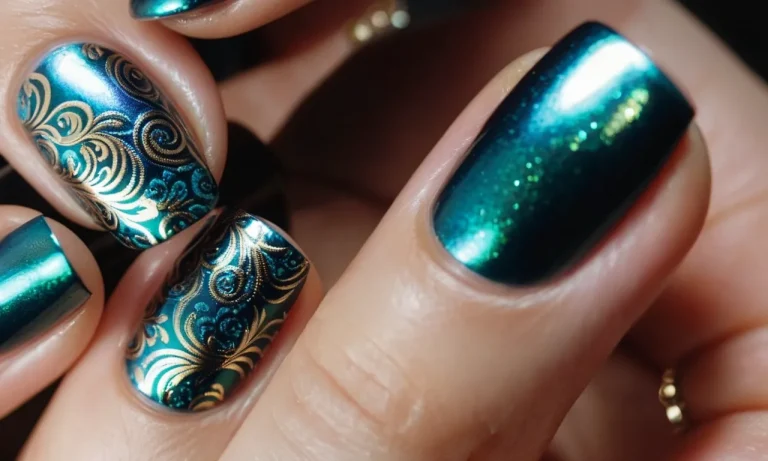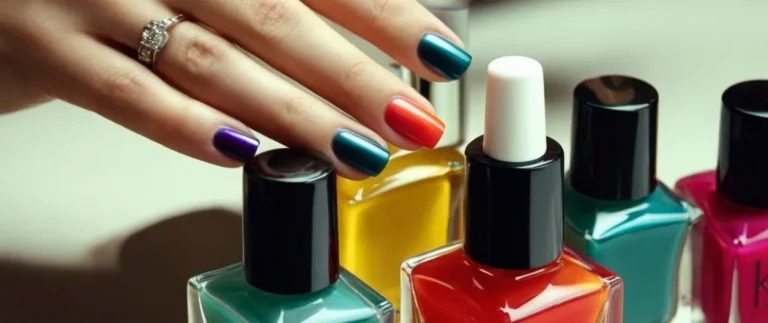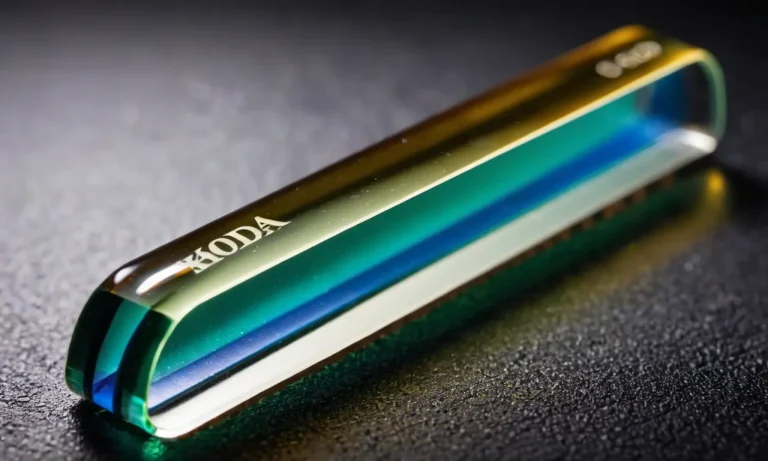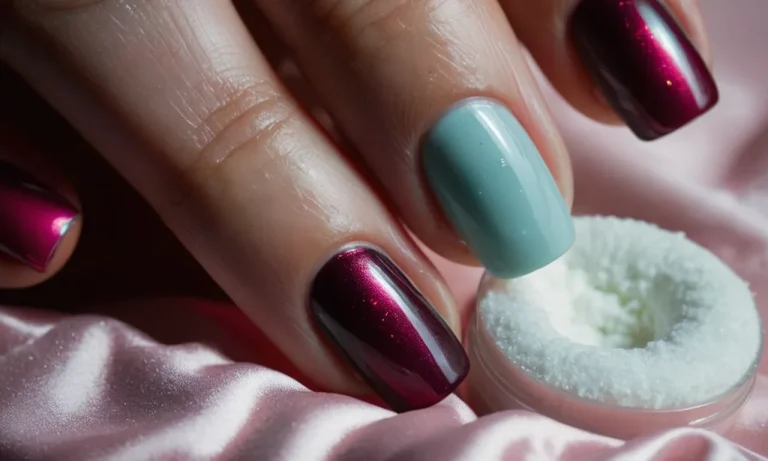What Does Nail Fungus Look Like? A Comprehensive Guide
If you’ve noticed changes in your toenails or fingernails, you may be wondering – do I have nail fungus? Nail fungus, also called onychomycosis, is a common condition that can cause nails to become discolored, thickened, or brittle.
In this comprehensive guide, we’ll give you a close look at the signs and symptoms of nail fungus, along with pictures, so you can determine if you need treatment.
If you’re short on time, here’s a quick answer: the most common signs of nail fungus include yellow, brown, or white nail discoloration, thickening or crumbling of the nail, and detachment of the nail from the nail bed.
What Causes Nail Fungus?
Nail fungus, also known as onychomycosis, is a common condition caused by a fungal infection. Understanding what allows fungus to invade and infect the nails can help in prevention and treatment.
Fungal Infection
Onychomycosis occurs when microscopic organisms called dermatophytes, yeasts or molds overgrow and infect the nail bed. Dermatophytes cause over 90% of fungal nail infections. These fungi feed on keratin, the protein that makes up hair, skin and nails.
Fungal spores can enter through tiny separations or cracks in the nail surface and cuticle. An alkaline pH environment also promotes nail fungus growth. Once established, the infection spreads deeper into the nail bed and thrives in warm, moist places like sweaty toes inside shoes and socks.
Risk Factors
Certain conditions put people at higher risk of developing nail fungus:
- Athlete’s foot – Having this fungal skin infection on the feet sets the stage for nail fungus.
- Sweaty feet – Perspiration creates an ideal environment for fungus.
- Minor nail or skin injuries – These allow fungi entry points under nails.
- Impaired immune system – Certain medical conditions like diabetes or leukemia increase susceptibility.
- Older age – Prevalence rises from 3% in 20s to over 20% in 70s.
- Genetics – Some people inherit tendencies for fungal infections.
- Smoking – Compromises circulation and healing.
- Using public showers or pools – Pick up fungus from surfaces.
Wearing tight shoes, keeping feet wet too long, sharing nail care items, and getting pedicures with dirty equipment also raise risks. Fungal infections spread easily from person to person and reinfection is common.
| Key Things That Cause Nail Fungus: | |
| 👉 Skin infection like athlete’s foot | 👉 Tight, sweaty footwear |
| 👉 Tiny cracks in nails | 👉 Impaired immunity |
| 👉 Injuries to nails/skin | 👉 Older age |
| 👉 Genetic tendencies | 👉 Smoking |
Signs and Symptoms of Nail Fungus
Discolored Nails
One of the most common signs of a nail fungus is a change in your nail color. As the infection progresses, the nail may turn yellow, brown, black, or green. The darkening color occurs as debris builds up under the nail.
This usually starts at the tip of the nail and slowly spreads towards the cuticle over weeks or months. White spots or streaks on the nail surface are also indicative of a fungal infection.
Thickened Nails
Fungal infections cause the keratin in your nails to develop abnormally, leading to a thickening of the nail. The increased thickness is most apparent near the tip of the nail. In severe cases, the nail can become several times thicker than normal.
As the nail thickens, it can become painful due to pressure on the nail bed. The thickened nail also becomes brittle and crumbly.
Brittle, Crumbly Nails
Nail fungus leads to a loss of moisture and protein in the nails, causing them to become dry and brittle. Brittle nails chip and crack easily. You may notice pieces of your nail flaking or crumbling off.
In advanced cases, the nail can become so brittle that it completely crumbles and falls off, exposing the nail bed underneath.
Distorted Nail Shape
While a healthy nail has a smooth surface and consistent thickness, a fungal infection causes the nail to become distorted. As the nail changes texture, it can become wavy, bumpy, or develop ridges and grooves. The edge of the nail may crumble and look nibbled.
Sometimes the nail warps and detaches from the nail bed.
Foul Smell
In some cases, a fungal nail infection can produce a foul odor. This is often described as a musty, rotten, or stinky smell coming from under the nail. The smell is the result of debris and keratin building up within the infected nail.
The odor is usually more noticeable when the socks or shoes are removed. Keep in mind that not everyone with nail fungus experiences odor.
Some key takeaways about the signs of nail fungus: Thickened, discolored, brittle nails that are distorted in shape point to a fungal infection. The changes usually start at the tip of the nail and advance back over time.
While not everyone has odor, some people notice a foul, rotten smell coming from the nail. Recognizing the early symptoms can lead to faster treatment and relief of your nail fungus.
Types of Nail Fungus
Distal Subungual Onychomycosis
Distal subungual onychomycosis (DSO) is the most common type of nail fungus, accounting for around 90% of fungal nail infections. As the name suggests, it affects the nail bed at the tip of the finger or toe. DSO starts as a small white or yellow spot under the toenail.
As it progresses, the infected area spreads to turn the toenail thick, brittle, and discolored. Debris can collect under the nail, and the nail plate can separate from the nail bed. This type of fungal nail infection is caused by dermatophyte fungi, most commonly Trichophyton rubrum.
These fungi thrive in warm, moist areas like showers, locker rooms, and pools. Toenail fungus spreads easily in these environments.
Symptoms of distal subungual onychomycosis include:
- Thickened, brittle, distorted toenails
- Discolored toenails – white, yellow, brown, black
- Debris building up under nails
- Toenails becoming raised or detached from the nail bed
As DSO progresses, it can be painful due to the collection of debris under nails. Seeking early treatment is important to avoid complications. advanced cases may require surgical removal of the nail.
White Superficial Onychomycosis
White superficial onychomycosis (WSO) is an unusual form of fungal nail infection. It’s caused by fungal invasion of the superficial nail plate rather than the nail bed. WSO accounts for around 10% of toenail fungal infections.
It’s characterized by the development of white, powdery patches or ‘spots’ on the toenail surface. Over time, the affected toenail becomes crumbly and brittle. As the spots merge, the nail can take on a chalky white appearance. Trichophyton mentagrophytes is the most common causative fungus.
WSO is often linked to nail trauma or damage that allows the fungus entry.
Symptoms of white superficial onychomycosis include:
- White, powdery patches on toenails
- Brittle, crumbly toenails
- Rough nail texture
- Nail plate thickening
WSO does not usually cause pain or discomfort. But it can lead to nail plate splitting and potential fungal spread. Treating it early provides the best chance of clearing the infection with topical antifungals.
Proximal Subungual Onychomycosis
Proximal subungual onychomycosis (PSO) is a rare form of fungal nail infection, accounting for less than 10% of cases. It starts at the cuticle, i.e., the proximal nail fold at the base of the nail. The fungal infection spreads from the cuticle slowly toward the nail tip.
As it advances, the nail becomes yellowish, stained, and detached from the nail bed. The most common causative fungi are nondermatophyte molds like Aspergillus and Fusarium species rather than dermatophytes.
Symptoms of PSO include:
- Yellowish discoloration of the toenails
- Detachment of the nail plate from the nail bed
- Brittle, distorted nails
- Fewer symptoms compared to distal subungual onychomycosis
People with PSO are often asymptomatic. But leaving PSO untreated risks the fungal infection worsening and spreading to other nails. Oral antifungal medications are usually required to treat it.
Candidal Onychomycosis
Candidal onychomycosis is the least common type of fungal nail infection, accounting for only around 1-2% of cases. It’s caused by yeasts from the genus Candida, most often C. albicans. Candidal nail infections are more likely to develop in people with chronic illnesses like diabetes or psoriasis.
They can also occur after nail trauma, or due to finger sucking or nail biting.
Symptoms of candidal onychomycosis include:
- Thickened, distorted, yellow nails
- Brittle, crumbly nail texture
- Paronychia – inflammation around the nail
- Cuticle inflammation and detachment
Candidal nail infections are often painful due to associated nail bed inflammation. They don’t respond well to normal antifungal treatments. Seeking prompt medical care for deeper antifungal therapies can help clear the infection.
When to See a Doctor
Nail fungus, also known as onychomycosis, is a common condition that can often be treated at home. However, in some cases it’s important to see a doctor for proper diagnosis and treatment.
Here are the main reasons you should make an appointment with your doctor if you suspect you have nail fungus:
The infection is severe or spreading
If more than half of one or more nails are affected by the fungus, it is considered a severe case. Additionally, if you notice the infection worsening and spreading to other nails over time, see your doctor.
You have diabetes, circulation issues, or a weakened immune system
People with certain medical conditions like diabetes, poor circulation, or compromised immune systems tend to develop more severe nail infections. For these individuals, prompt medical treatment is recommended.
Over-the-counter treatments haven’t worked
You can try treating minor nail fungus with OTC topical ointments for up to 12 weeks. If you don’t see improvement by then, make an appointment with your doctor. They can prescribe stronger antifungal medications.
The infection is causing you pain or discomfort
In some cases, a fungal nail infection can be painful. This usually happens when the infection has been left untreated for a long time. See your doctor right away if your infected nails are causing you pain.
You have yellow streaks or crumbling nails
Yellow streaks under the tip of the nail are a common sign of nail fungus. However, nails that become thickened, brittle and crumbly may indicate a fungal infection plus a secondary bacterial infection. See your doctor if you notice these worrisome changes in your nails.
Catching and treating nail fungus early leads to better outcomes. See your doctor promptly if OTC treatments aren’t helping or if your infection is severe. With prescription medications and possible nail removal, most fungal nail problems can be cured.
Nail Fungus Treatment Options
Over-the-Counter Antifungal Creams
Over-the-counter antifungal creams containing ingredients like clotrimazole, miconazole, and tolnaftate can help treat mild cases of nail fungus when applied directly to the infected nail once or twice a day.
These inexpensive topical medications work by killing the fungus on the nail surface and are available at any pharmacy without a prescription. Consistent application and patience is key, as it can take 3-6 months for new, healthy nail growth to appear.
For best results, make sure to file down thickened nails before applying the cream. While OTC antifungals don’t always fully eliminate an infection, especially if the fungus has spread to the nail bed, they are an easy first treatment option with minimal side effects like skin redness or irritation.
Their convenient application at home makes them a good choice over more intensive prescription treatments.
Prescription Oral Medications
For moderate or severe nail fungus, oral antifungal medications prescribed by a doctor may be necessary. These work by circulating through the bloodstream to reach and kill stubborn fungal infections affecting multiple nails or surrounding skin.
Common prescription pills include terbinafine (Lamisil), itraconazole (Sporanox), and fluconazole (Diflucan). Though highly effective at nail fungus clearance rates up to 80% after 3 months, they can cause side effects like headache, diarrhea, rash, or liver damage in rare cases.
Frequent blood testing helps monitor liver enzyme levels during treatment. Another downside is the high cost without insurance, often exceeding $100 per month. Still, oral meds offer the convenience of an easy pill over topical creams and can more reliably produce complete cures, especially for individuals with diabetes, inflammatory conditions, or impaired immune systems prone to severe fungal infections spreading internally.
Laser Therapy
Laser treatments applied directly to the nail have emerged as a newer nail fungus cure over the past decade. Podiatrists use specialized devices that shine intense, focused beams of light and heat that selectively damage fungal cells.
Most treatments involve 2-3 sessions spaced 2-4 weeks apart for optimal results. According to research studies, laser therapy clears nail fungus in 38%-88% of cases. The technology offers a safe, fast in-office procedure without side effects or drug interactions.
However, it does not prevent reinfection later on. The major downside is the high out-of-pocket cost, averaging $500-$1,000 altogether, that insurance does not cover since it is viewed as a cosmetic treatment.
Overall, laser therapy makes sense for those that can afford it and desire a convenient option for moderate or severe nail fungus without taking oral antifungals.
Nail Removal
In the most severe cases where fungal infection causes the nail to become loose, crumbly, distorted and painful, temporary or permanent nail removal may be recommended. For toenails, a podiatrist can surgically extract part or all of the nail as an in-office procedure under local anesthesia.
This fully exposes the underlying nail bed and allows the doctor to remove all infected tissue before prescribing a course of oral antifungals to clear any remaining fungus internally and prevent recurrence. After several months, the nail may grow back normally assuming the infection is gone.
Permanent nail removal is an option for recurrent fungal infections causing pain or mobility problems. Here, the nail root is fully destroyed so no regrowth occurs. The exposed nail bed can then be covered with a skin graft from elsewhere on the foot.
Nail removal provides rapid relief when fungus has severely impacted quality of life, however, some may prefer to keep their nail if other treatments are still an option.
Conclusion
In summary, key signs of nail fungus include changes in nail color, thickness, shape, and texture. While fungus can affect fingernails, it is more commonly seen in toenails. If you think you may have nail fungus, see your doctor, who can confirm diagnosis and recommend the best treatment option for your situation.
With prescription antifungals and persistence, nail fungus can be cured. Don’t hesitate to seek help so you can get back to enjoying healthy, beautiful nails.

